So long, coal soot -- life transformed in zero-carbon village
Xinhua
04 Jun 2025

YINCHUAN, June 4 (Xinhua) -- Zhou Xuelin, a villager from northwest China, bid farewell to his old house, which had been blackened by coal soot, in September last year; the winter days spent choking on soot spewed from coal-heating stoves were finally behind him.
The new house Zhou moved into was constructed, under unified planning, by Xingsheng Village in Pingluo County of Ningxia Hui Autonomous Region. It is a detached, white bungalow among rows of similar abodes.
In addition to being bright and clean, the new houses feature a mouthful concept that Zhou was not very familiar with -- they were certified as near-zero carbon architectures. Little did the 62-year-old farmer expect that he could one day lead a pioneering lifestyle by living in an energy-efficient house.
Seventy-six such rural houses have been built, each equipped with a rooftop photovoltaic power panel and an air-source heat pump. Of these, 33 belonging to Phase II of the construction were reinforced with heat-trapping insulation materials. Power generated from photovoltaic installations drives the air-source heat pump that produces heat for the building.
As northwest China typically witnesses sub-zero temperatures during winter, winter heating represents a major source of pollution in rural areas.
With these buildings now complete, Xingsheng Village has become Ningxia's first near-zero carbon village with tremendous benefits.
"Living in the old house was quite a hassle when it came to heating; someone always had to worry about feeding the stove with coal and cleaning the ashes. It would get stuffy as soon as you walked in, and the place was dirty," Zhou said.
"Now, the new house is even more comfortable than living in an apartment in the city. My children and grandchildren visit more often, and they feel relaxed here."
Zhou spent around 60,000 yuan (about 8,348.5 U.S. dollars) decorating his home and bought many household appliances to maximize his electricity usage in daily life, even preparing two electric pans for cooking, as the electricity generated from the rooftop is cheaper than gas.
Saving money is a top concern for the villagers. Huang Xuejun, a resident, said that although coal prices have decreased somewhat over the past two years, heating with coal during the winter still costs over 4,000 yuan at least. In contrast, after moving into the new house, the electricity bill for an entire heating season is only about 1,500 yuan.
Moreover, the Phase II houses were built with prefabricated graphene heating wall panels that have better insulation and triple-glazed windows. An extra 20 centimeters of insulation layer was added to the walls, according to He Chao, the Party chief of Xingsheng Village, noting that the insulation is crucial to lowering overall power consumption.
Better still, the new houses can earn money for their residents. Each of the 33 households in Phase II boasts an installed photovoltaic generation capacity of 5.4 kilowatts and houses an energy storage battery of 10 kWh, which functions as a super-sized charger. The excess electricity generated during the day can be fed back into the grid.
At the end of each month, a settlement is made, and villagers are paid for the electricity output they supply to the grid. The village estimates that the power generation could earn each household approximately 1,500 yuan a year.
Xingsheng Village has a population of 1,826, over 700 of whom are permanent residents, and about 58 percent of rural houses stand empty as many villagers have migrated to cities.
Xingsheng Village began to construct new rural houses in 2021. The project was listed as a demonstration project of renewable energy construction, meaning that the village was allocated government funding. Besides, the project enlisted demolition subsidies and earthquake-resistant renovation subsidies. The rest, a small portion, is raised by the villagers themselves.
China aims to peak carbon emissions by 2030 and realize carbon neutrality by 2060. To achieve this, a green transition in the production and way of living has been promoted across the nation's vast rural regions in recent years. Many zero or near-zero carbon villages have emerged across the country.
China rolled out a five-year initiative to promote the development of zero-carbon villages and townships in January 2023. The initiative aims at leveraging renewable energies available to rural areas, energy conservation and storage technologies, to replace fossil fuels with renewables.
